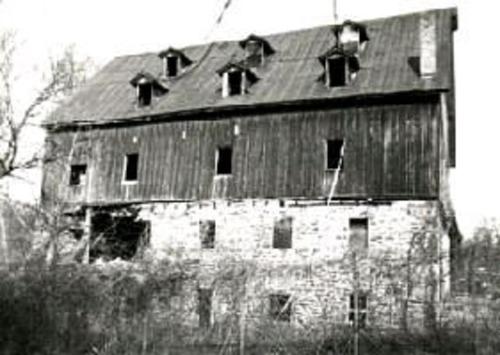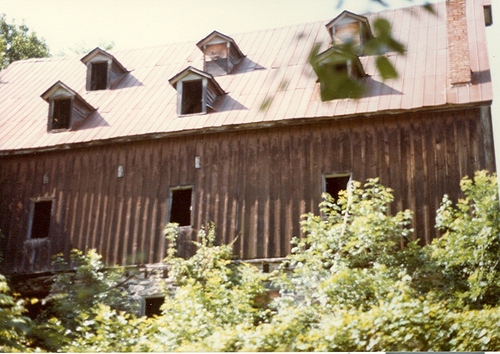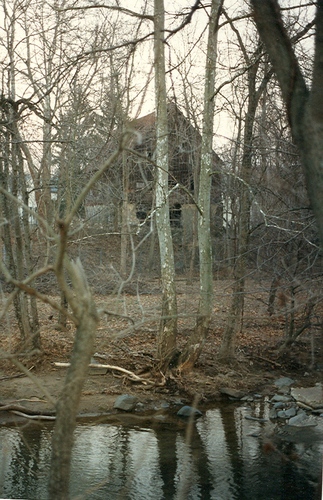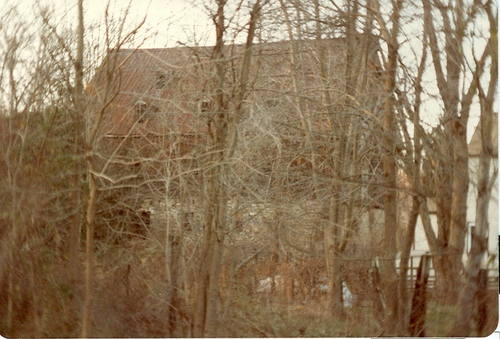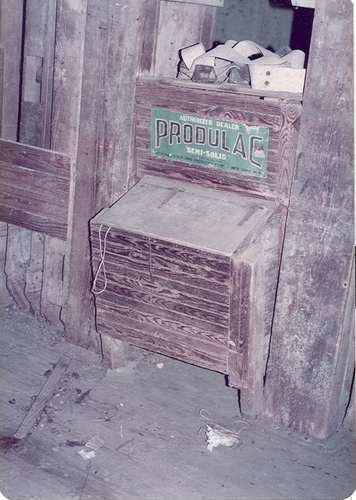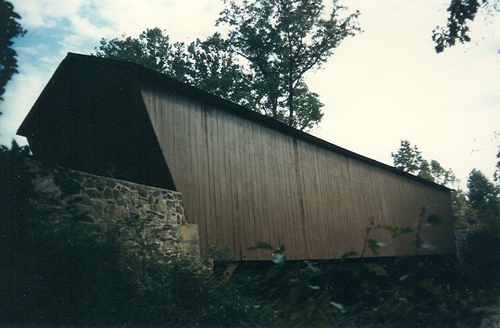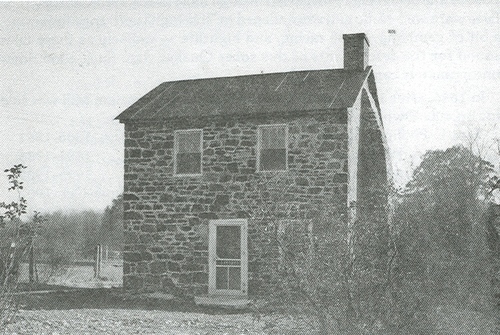New Hope for the Jerusalem Mill
Welcome!
NEW HOPE FOR THE JERUSALEM MILL
Jerusalem Mill, MD., Part II
By Terry L. Linton Regional Reporter
Old Mills News © ISSN 0276-3338
Publication of the Society for the Preservation of Old Mills Vol. XV, No 3, Whole Number 60, © Summer 1987 page 10
LINTON & BIRD CHRONICLES, Volume IV, Issue 3, Fall © 2009, ISSN 1941-3521
photos added in
LINTON & BIRD CHRONICLES, Volume V, Issue 2, Summer © 2010, ISSN 1941-3521
_____________________________________
NEW HOPE FOR THE JERUSALEM MILL
The original, 1772, unique horizontal water wheel is long gone! It was replaced by two pitch-black water wheels in the 1880's. Now their replacement, a twin Burnham-Fitz iron turban, lays awash, half buried, in the mud, in the wheel-pit room of this two hundred and fifteen year old Jerusalem Merchant Grist Mill! This mill was built by, the Quaker millwright, Isaiah Linton, for miller, David Lee, in what was then Baltimore County, Maryland. The Mill's unique dormer windows are almost all broken out by vandals. Along with most all of the other windows in this five story mill. The roof leaks, and the wooden gutters are gone. A high chain link fence with a, "NO TRESPASSING", sign on it, can hardly be seen because of the trees and undergrowth, which covers most of the fence and the first two stories. But worst of all, there is a large portion of the east stone wall which has disintegrated, leaving a big gaping hole, and questioning just how long this massive, historical mill can stand after being left derelict and forlorn by the State of Maryland! The Jerusalem Mill has been decaying and crumbling away, little-by-little, for the last twenty-six years! Today, the Mill which was purchased by the State of Maryland, in 1961, is deserted, but still stands precariously on it's crumbling stone foundation, as a haunting reminder of Maryland's thriving, Quaker industrial and agricultural past.
Above photo: North side of Jerusalem Mill in 1984 of Quaker master millwright Isaiah Linton’s Lee’s merchant water grist mill, later to be known as Jerusalem Mill. The mill located on Little Gunpowder Fall was completed in August 1772 in what was then Baltimore County, now Hartford County Maryland. Photo taken in 1984 by ©Terry Louis Linton.........................................................................................................................................................................Below Photo: North side Jerusalem Mill Photo taken in 1989 by ©Terry Louis Linton.
In the twenty-three years, from 1961 to 1984, interest in the Mill would raise every five years or so, but not accomplishing much in response. However, in 1971 and 1976, some stabilization work was completed by the Henry Knott Construction Company, under contract to the State of Maryland. The work stabilized the interior frame structure above the first floor and kept the Mill standing.
Jerusalem Mill South Side from Jerusalem bridge Photo taken in 1984 by ©Terry Louis Linton.
Jerusalem Mill the east side Photo taken in 1984 by ©Terry Louis Linton.
Jerusalem Mill northeast corner second floor main milling level in 1984, in the same area were the weighing scales and a millers desk with a 1960 calendar on the wall. Photo taken in 1984 by ©Terry Louis Linton.
Now, the Jerusalem Mill has new hope with the forming of the "Friends of Jerusalem Mill". It all began in the fall of 1984, when fourteen year-old, Scott Sanders, urged his father, Harry Sanders, to organize their Kingsville Community to investigate ways of preserving the old mill. Scott said, "I ride my bike by there every day and it's just about 150 yards from my house. For over 200 years it's been standing there. It's got a lot of historical background and it should be saved". In June 1985, the Kingsville Civic Association met to discuss the preservation of the Jerusalem Mill. The Kingsville Civic Association had earlier led a successful effort to restore the old Jericho Covered Bridge. The Jericho Covered Bridge crosses the Little Gunpowder Falls River just down from Isaiah Linton's Jerusalem Mill. The road led from Jerusalem Grist and Saw Mills to his Jericho Grist and Saw Mills. In August of 1985, the "Friends of Jerusalem Mill" was formed, with Harry Sanders as it's Chairman, he said at the time, "our minimum goal will be to keep the Mill structurally sound, and hopefully, to completely renovate it".
Jericho Covered Bridge in 1984, Photo by Diane Linton. In © 1865, David Lee II, of Lee’s Mill and the overseer of the roads in the area, lobbied for a covered bridge to connect the cotton mills of Jericho, a spade factory and wrought iron works in Franklinville, Baltimore County, with the his flour mill and blacksmith shop in Jerusalem, Harford County.
The first action, the Friends of Jerusalem Mill undertook was to cleanup around the mill. Next, they cleared away the tangled brush and trees. Then, the removal of a fallen tree from the roof in March of 1985. The Friends of Jerusalem Mill found out that the, "Jerusalem Mill Site Complex", also included the mill head race and tail race, a one story stone blacksmith's shop, the stone foundation of the wheelwright's shop, and the small two-story stone structure known as the "gun factory". The gun factory dates back to the original, 1725, "Bonds Water Mills". In 1727 John Bond erected, "a water grist mill on the North Bank, of the Little Falls". This mill was "washed away, by flood waters, on or about September 1749". The gun factory was erected in 1741 and was first used as a millers house. This structure was later used by David Lee, during the Revolutionary War, to make flintlock muskets for the Maryland Militia. Later it was used as a cooper's shop, cider mill, cannery, cabinet-makers shop, and back to use as the millers house. In the 20th Century it was the home to a family with six children.
GUNSMITH SHOP, In 1774, at the beginning of the Revolutionary War, despite their Quaker beliefs, Isaiah LINTON, David LEE, Gittings WILSON, John KIDD, James WOOD, Nathan BOND, and blacksmith, Edward CONNARD, started manufacturing black walnut gun stocks, and assembling flintlock muskets for the Maryland Militia. This was done in the two story stone building, still standing today, behind Lee's Merchant Mill. They were charged, by the Gunpowder Quaker Meeting Elders, with "learning the art of war", and the elders noted, "we think it our duty to testify against all carnal war and bloodshed".
The Forgotten Millwright, Isaiah Linton (1739-1775) Terry Louis Linton © 1986
Master millwright Isaiah LINTON (1739-1775) (Brief Historical Sketch)
Master millwright Isaiah LINTON (1739-1775) Project
How are you related to Isaiah LINTON (1738-1775)
Linton Research Fund, Inc., HOME PAGE
Past BIRD Articles from the BIRD Chronicles
Past LINTON Articles from the LINTON Chronicles
The LINTON & BIRD Chronicles on Facebook
"Thanks for Visiting, come back when you can stay longer" Terry Louis Linton © 2007 ![]()
